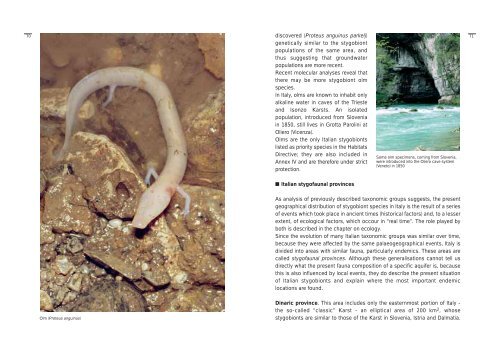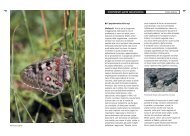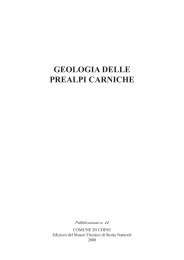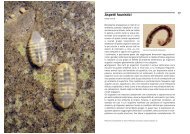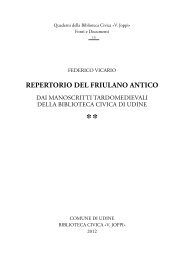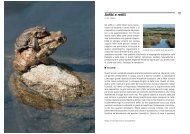Despite its inhospitable appearance and lack of any ... - Udine Cultura
Despite its inhospitable appearance and lack of any ... - Udine Cultura
Despite its inhospitable appearance and lack of any ... - Udine Cultura
Create successful ePaper yourself
Turn your PDF publications into a flip-book with our unique Google optimized e-Paper software.
70<br />
Olm (Proteus anguinus)<br />
discovered (Proteus anguinus parkelj)<br />
genetically similar to the stygobiont<br />
populations <strong>of</strong> the same area, <strong>and</strong><br />
thus suggesting that groundwater<br />
populations are more recent.<br />
Recent molecular analyses reveal that<br />
there may be more stygobiont olm<br />
species.<br />
In Italy, olms are known to inhabit only<br />
alkaline water in caves <strong>of</strong> the Trieste<br />
<strong>and</strong> Isonzo Karsts. An isolated<br />
population, introduced from Slovenia<br />
in 1850, still lives in Grotta Parolini at<br />
Oliero (Vicenza).<br />
Olms are the only Italian stygobionts<br />
listed as priority species in the Habitats<br />
Directive; they are also included in<br />
Annex IV <strong>and</strong> are therefore under strict<br />
protection.<br />
■ Italian styg<strong>of</strong>aunal provinces<br />
Some olm specimens, coming from Slovenia,<br />
were introduced into the Oliero cave system<br />
(Veneto) in 1850<br />
As analysis <strong>of</strong> previously described taxonomic groups suggests, the present<br />
geographical distribution <strong>of</strong> stygobiont species in Italy is the result <strong>of</strong> a series<br />
<strong>of</strong> events which took place in ancient times (historical factors) <strong>and</strong>, to a lesser<br />
extent, <strong>of</strong> ecological factors, which occour in “real time”. The role played by<br />
both is described in the chapter on ecology.<br />
Since the evolution <strong>of</strong> m<strong>any</strong> Italian taxonomic groups was similar over time,<br />
because they were affected by the same palaeogeographical events, Italy is<br />
divided into areas with similar fauna, particularly endemics. These areas are<br />
called styg<strong>of</strong>aunal provinces. Although these generalisations cannot tell us<br />
directly what the present fauna composition <strong>of</strong> a specific aquifer is, because<br />
this is also influenced by local events, they do describe the present situation<br />
<strong>of</strong> Italian stygobionts <strong>and</strong> explain where the most important endemic<br />
locations are found.<br />
Dinaric province. This area includes only the easternmost portion <strong>of</strong> Italy -<br />
the so-called “classic” Karst - an elliptical area <strong>of</strong> 200 km 2 , whose<br />
stygobionts are similar to those <strong>of</strong> the Karst in Slovenia, Istria <strong>and</strong> Dalmatia.<br />
71


